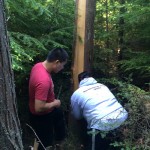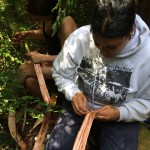New Rule To Reveal How Many Oil Tanker Trains Passing Through Wash.

Matthew Brown AP Photo
By Bellamy Pailthorp, KPLU
The rapid increase of trains carrying crude oil across the region has raised alarm bells in the wake of a series of serious accidents. Communities and first responders say they can’t adequately prepare for possible disasters because railroads are not required to give any information on the shipments.
That’s about to change, at least to some extent, with a new regulation that takes effect Friday.
An emergency order from the U.S. Transportation Department will require railroads to tell states how many trains carrying highly-volatile Bakken crude are expected to travel through each week, and on which routes.
The order was issued just a week after the latest oil train accident — a derailment in Lynchburg, Virginia — that sent eight-story fireballs into the sky.
A ‘Small Step’; ‘Hardly Where We Need To Be’
“I think it’s a very small step in the right direction,” said Eric de Place, policy director with Seattle’s Sightline Institute, an environmental think tank that has been reporting on what it calls an emerging “pipeline on rails.” He says the new federal rules don’t go far enough.
“Let’s keep in mind, this is not requiring them to use safer tank cars. This is not requiring them to slow down in our neighborhoods. This is not requiring them to inform emergency responders of the dangers,” de Place said. “All they’re having to do is tell us some very rough figures about how many potentially explosive trains are in our states. So, it’s better than nothing, but it’s hardly where we need to be.”
Sightline has been documenting the growth in oil train traffic. DePlace says nationally, it’s increased nearly 60-fold over the past five years.
Info Will Help Communities Better Prepare
Barb Graf, director of emergency management for the city of Seattle, testified at a recent hearing on rail safety before the U.S. Senate.
She says fire departments need to know when mile-long oil trains are passing through. The new rule will help communities better prepare for disasters “in the same way that we have ongoing discussions with geologists and scientists about what’s our earthquake threat, what’s the recurrence rate and that type of thing,” she said.
“This just gives us more information about the kinds of hazardous materials that would be in our community at any given time,” Graf said.
Advocates for more regulation say they’ll keep pushing. They want more specifics on the shipments, as well as tougher standards for tank car safety. They also say it should apply to all shipments of oil by rail, not just the longest trains carrying Bakken crude.
Parisian Prom: Native prom at the Marysville Opera House

By Andrew Gobin/Tulalip News
Tulalip Youth Services presented Native Prom – A Night in Paris the evening of May 30. With donated ball gowns and tuxedos, as well as volunteer stylists, Youth Services wanted to give everyone the chance to look their best for a night of elegance. Hosted at the historic Marysville Opera House, students stepped into a world of sophistication.

Photo: Andrew Gobin/Tulalip News
As prom began, volunteer stylists Tisha McLean, Yvonne Williams, and Celum Hatch were just finishing up helping girls with their hair and makeup in one of the house dressing rooms. As more students arrived, the hardwood filled with dancers.

Photo: Andrew Gobin/Tulalip News
While the setting was a scene from the roaring twenties, students danced to the modern tunes of Steve Aoki, Sir Mix-A-Lot, and the Ying yang Twins. And where would any high school dance be without the signature, choreographed group dance? As most school dances have played the Y.M.C.A., The Hustle, and the Electric Slide throughout the latter half of the twentieth century, the newest group dance craze is Cupid’s, Cupid Shuffle.

Photo: Andrew Gobin/Tulalip News
Finally, the anxiously awaited announcement of the Prom Royalty. Selected at the dance, couple Ayrik Miranda and Samantha Marteney were crowned Prince and Princess. Becca Marteney was crowned Prom Queen, with Heritage Hawks star Bradley Fryberg the reigning Prom King.

Photo: Andrew Gobin/Tulalip News

Photo: Andrew Gobin/Tulalip News
Check out more photos here
Andrew Gobin is a staff reporter with the Tulalip News See-Yaht-Sub, a publication of the Tulalip Tribes Communications Department.
Email: agobin@tulalipnews.com
Phone: (360) 716.4188
TransCanada shuts down southern leg of Keystone XL Pipeline, raising “suspicions”

By Julie Dermansky, June 3, 2014. Source: Desmog Blog
“Pipelines aren’t normally shut down for maintenance shortly after being started up. They may have planned it but something is wrong,” an industry insider told DeSmogBlog. “A two day shutdown on a new line raises suspicions.”
The Pipeline and Hazardous Material Safety Administration was unable to provide an answer to DeSmogBlog when asked to confirm if the shutdown was due to routine work today.
“The Gulf Coast Pipeline is the safest oil pipeline built in the United States to date,” TransCanada spokesman David Sheremata told DeSmogBlog.
TransCanada states this claim often, despite the serious issues cited by pipeline regulators in warning letters, along with the two new special conditions added to the existing 57 required if the northern section of the pipeline is permitted.
Can that statement be true after an undisclosed number of new girth welds were introduced into the pipeline during the repair process? Despite the high weld rejection rate that regulators warned TransCanada about, a new pressure test was not required to check the new welds.
“During the first week 26.8 percent of the welds required repairs, 32.0 percent the second week, 72.2 percent the third week, and 45.0 percent the fourth week. On September 25, 2012, TransCanada stopped the Spread 3 welding after 205 of the 425 welds, or 48.2 percent required repairs.” PHMSA wrote TransCanada on September 26, 2013.
“Let’s remember, TransCanada claimed that the Keystone I pipeline system would be one that would ‘meet or exceed world-class safety and environmental standards’ and leak an average of 1.4 times a decade,” Rocky Kistner, a communications associate for the Natural Resources Defense Council, wrote on the NRDC‘s blog.
“In just its first year of operation, Keystone leaked 14 times, a hundred times more leaks than TransCanada predicted. On its Canadian side, the pipeline has leaked at least 21 times.”
TransCanada’s Bison Pipeline in Wyoming also had to be shut down after a portion of it ruptured six months after it was put into operation.
Michels Corporation, one of the contractors that worked on the Gulf Coast Pipeline, was also the contractor for Bison.
Evan Vokes, former TransCanada employee turned whistleblower, told the Wyoming Tribune that speed was put ahead of safety on that project. He noticed problems with pipe alignment welding, excavation and backfilling, among other things while working on that project.
“It is questionable that a pipeline which generates millions of dollars a day, in operation for barely six months, is suddenly off,” Kathy DaSilva, an activist representative of the Tar Sands Blockade, told DeSmogBlog.
This latest incident led the Tar Sands Blockade to renew its call for Keystone XL‘s southern leg to remain shut down until further testing is done to ensure the pipeline’s integrity.
The advocacy group Public Citizen also called for a new pressure test on the pipeline.
“Given the stakes – the looming potential for a catastrophic spill of a hazardous crude along a pipeline that traverses hundreds of streams and rivers, and that comes within just one or two miles of some towns and cities – it would be irresponsible for the federal government to allow tar sands crude to start flowing through the southern leg without ordering a complete hydrostatic retesting of the line and a thorough quality assurance review,” their report on the Keystone XL‘s southern route concluded.
The big question remains: is the Obama administration playing Russian roulette with Texas and Oklahoma aquifers by not requiring the retesting on the Gulf Coast Pipeline?
Strawberry King and Queen crowned at Tulalip elders lunch: Tribal offices donate gift baskets for raffle
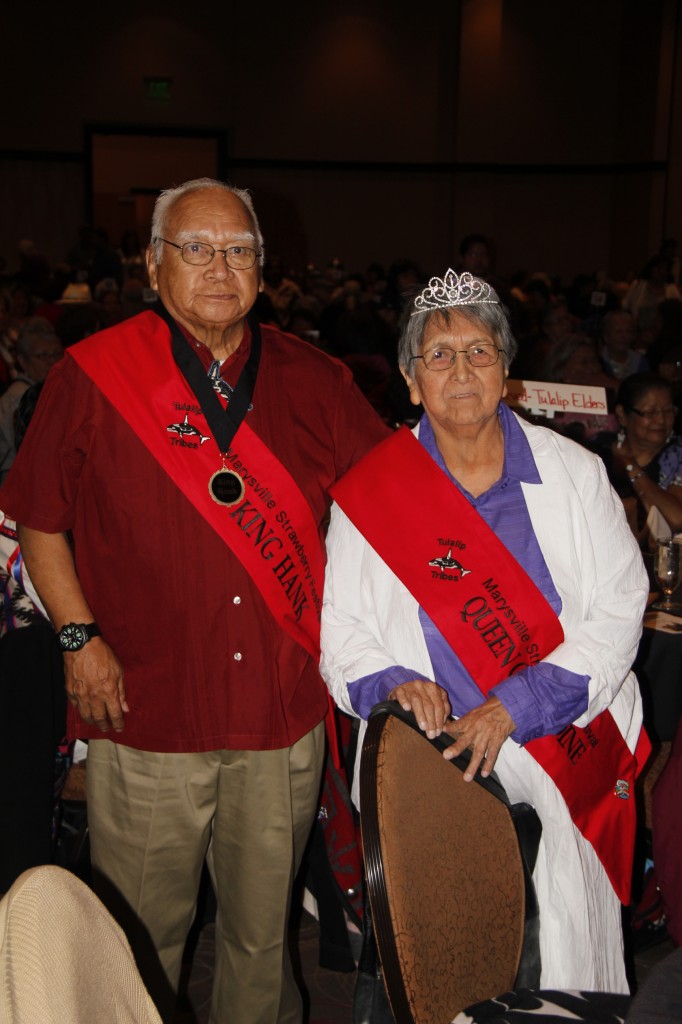
Photo: Andrew Gobin/Tulalip News
By Andrew Gobin/Tulalip News
The Marysville Strawberry Festival Senior and Junior Royalty crowned Geraldine and Hank Williams as Strawberry King and Queen at Tulalip’s elder luncheon May 29. Each year, Tulalip elders nominate two of their own to be crowned at the annual elder luncheon.
“I look around every year to see who deserves a nomination. Geraldine and Hank have paid their dues to the community,” said Tulalip elder Virginia Carpenter, who nominated this year’s royalty.
The luncheon is much more than a celebration of the Strawberry Court, it is an intertribal event, open to all indigenous elders. Nearly 900 elders from Pacific Northwest Native communities from as far north as Alaska, and from around Washington and Oregon attended. Many of the tribal offices donated gift baskets to be raffled off at the event.
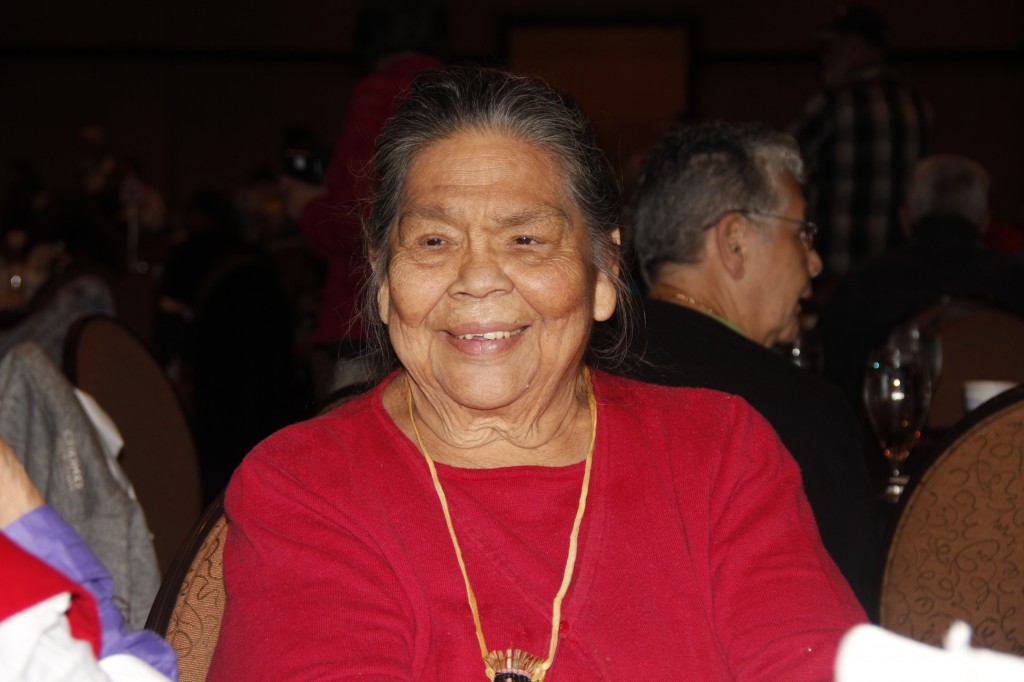
Photo: Andrew Gobin/Tulalip News
“I come because I’m so old. Oh, just kidding,” said Tulalip elder Loretta James. “I come to see everyone. And I like to see all the different departments chip in for the gift basket give away. I like to see them give back to this community.”
Tulalip elder Richard ‘Two Dogs’ Muir said, “I come for the company, and for the stories. Look around this room, at how much history is sitting in this room, all the advice. Quote of the day so far is, ‘Be true to yourself, pay no attention to what other people think.’ There is so much more to learn from these elders too, if you would just talk with them.”
Two Dogs donated a special beaded rattle to the raffle.
He said, “I only work when I am in the right mindset, no negative thoughts. So this rattle is lucky to whoever wins it.”
Everyone was smiling and having a good time, joking and teasing one another.
Francis Peters of Swinomish joked, “I thought I was too old for these things, but I guess not. I wasn’t coming down here, but I guess I got too close to the elder building, and they twisted my arm and put me on the van.”

Photo: Andrew Gobin/Tulalip News
The Tulalip Tribes honored the eldest visiting man and woman, who were Mickey Walker, 97, of Kingman Arizona, and Amelia Sohappy, 92, of Yakima. Charlie ‘Red’ Sheldon was honored as the oldest Tulalip, who just celebrated his 98th birthday on May 5.
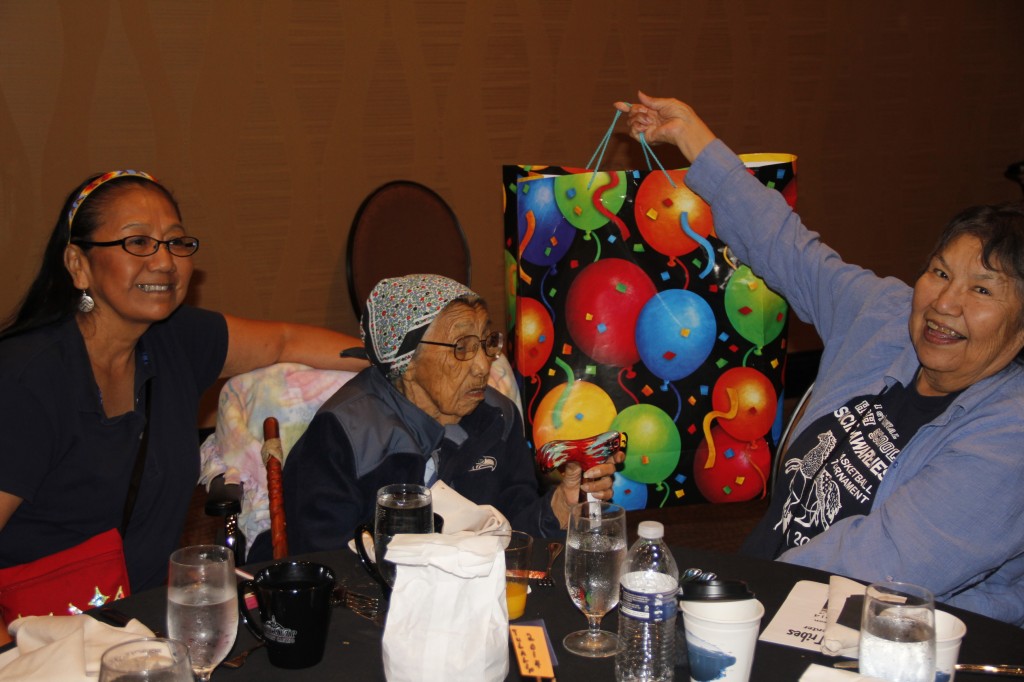
Photo: Andrew Gobin/Tulalip News
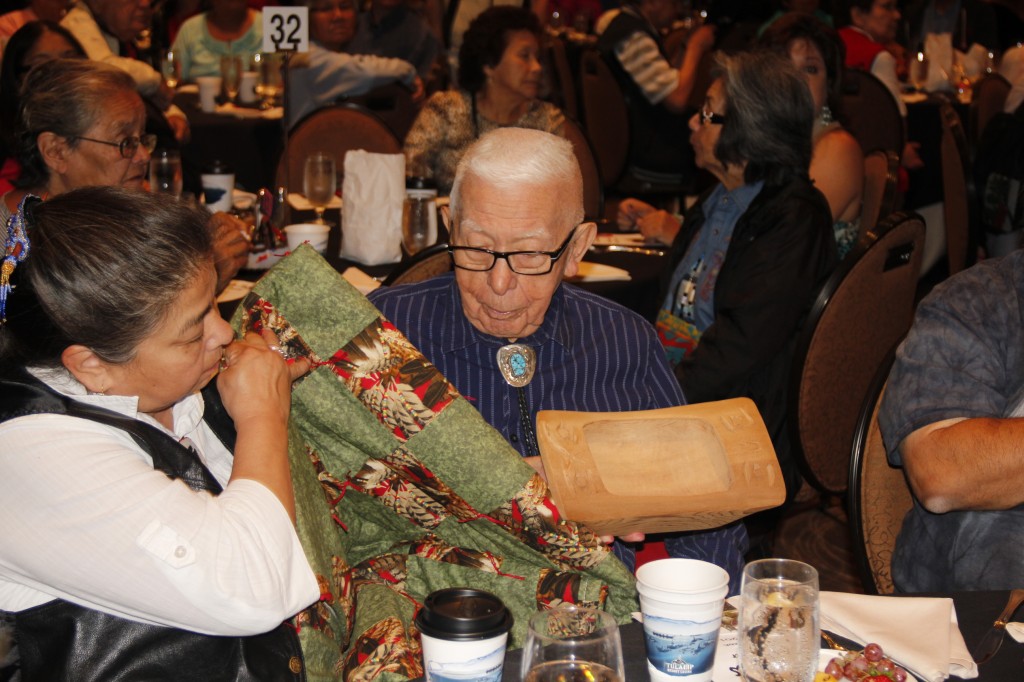
Photo: Andrew Gobin/Tulalip News
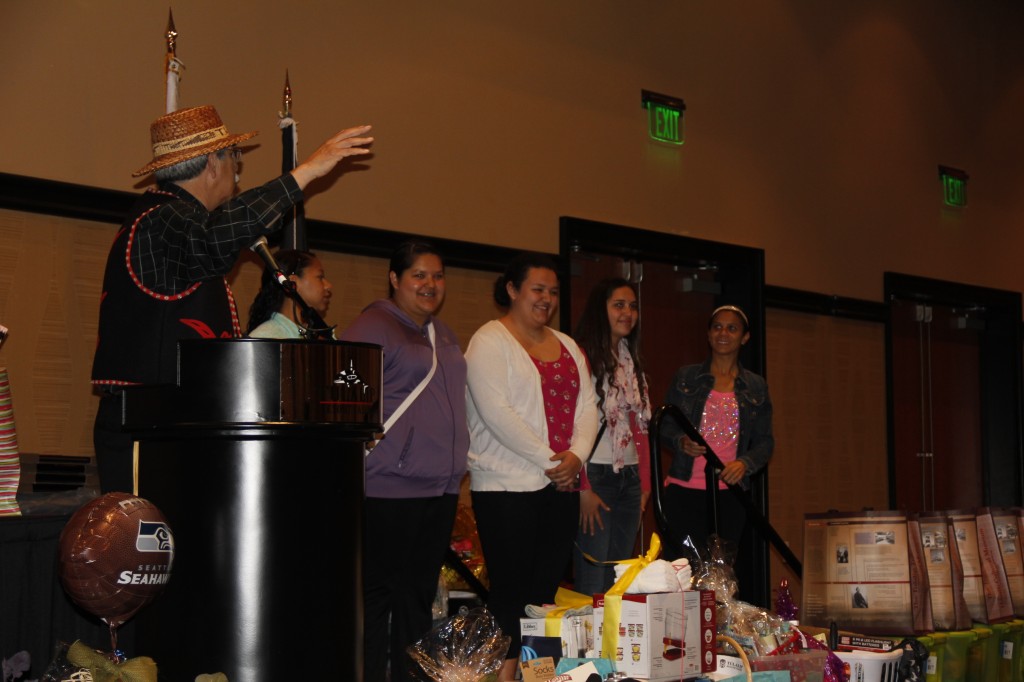
Photo: Andrew Gobin/Tulalip News
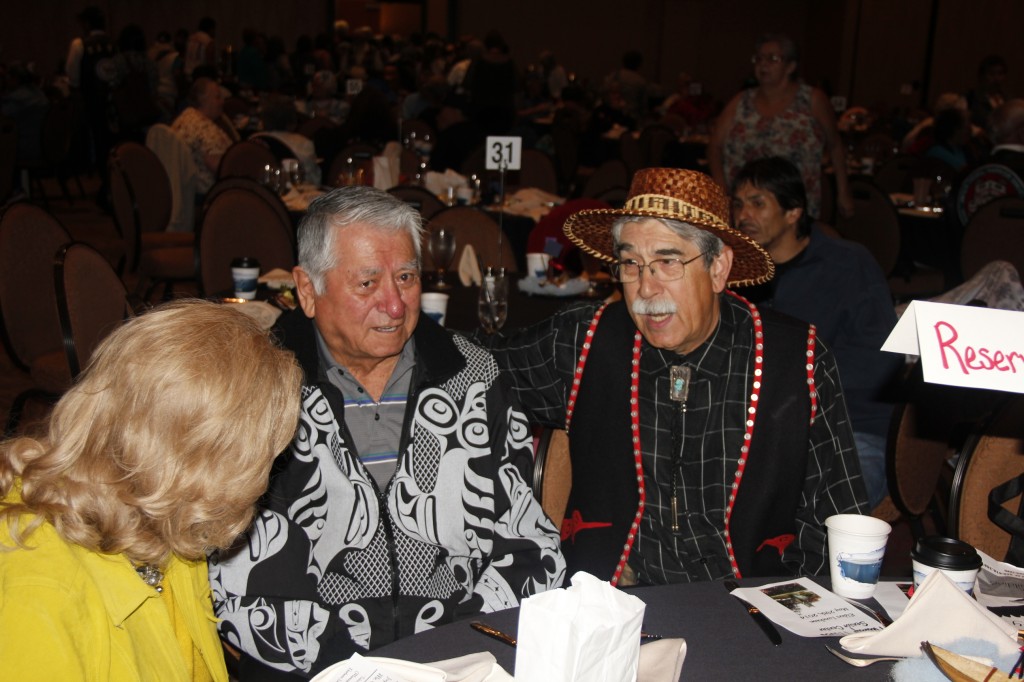
Photo: Andrew Gobin/Tulalip News
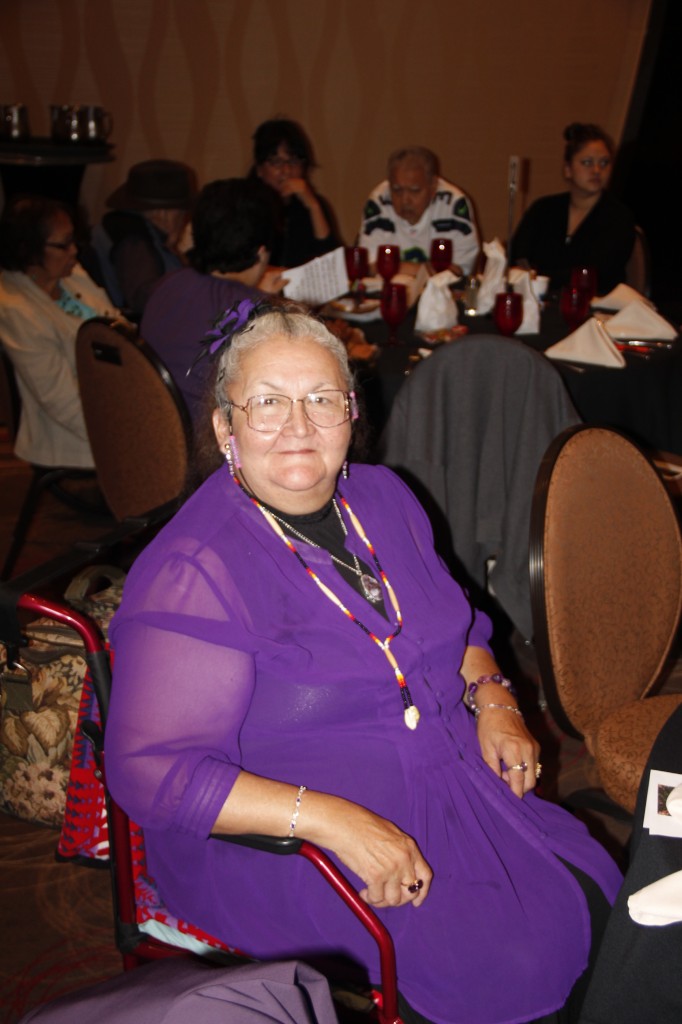
Photo: Andrew Gobin/Tulalip News
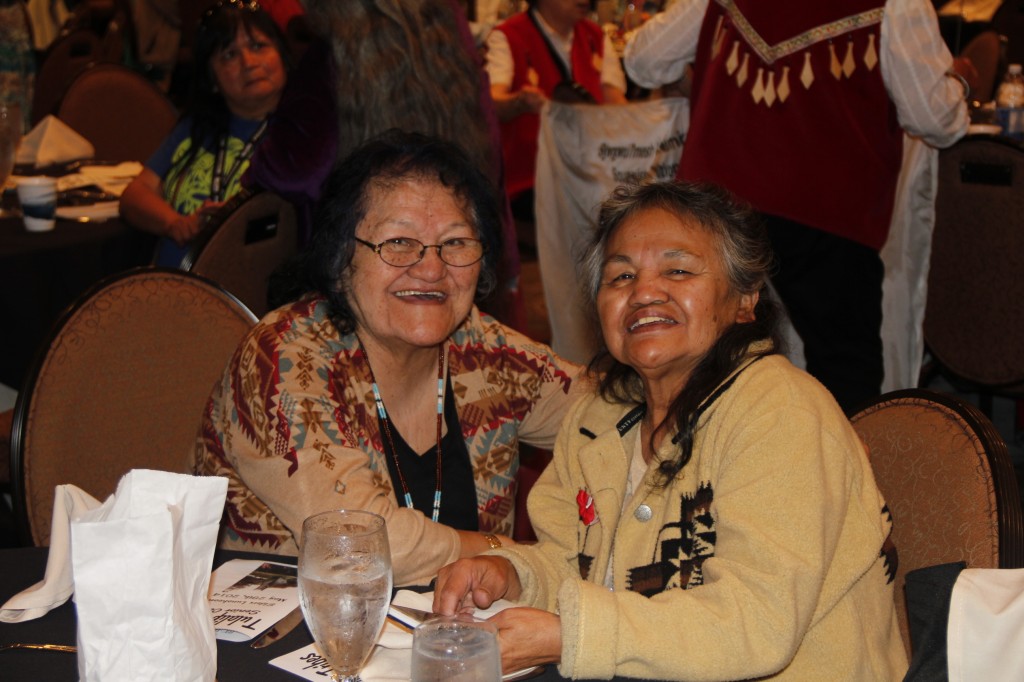
Photo: Andrew Gobin/Tulalip News
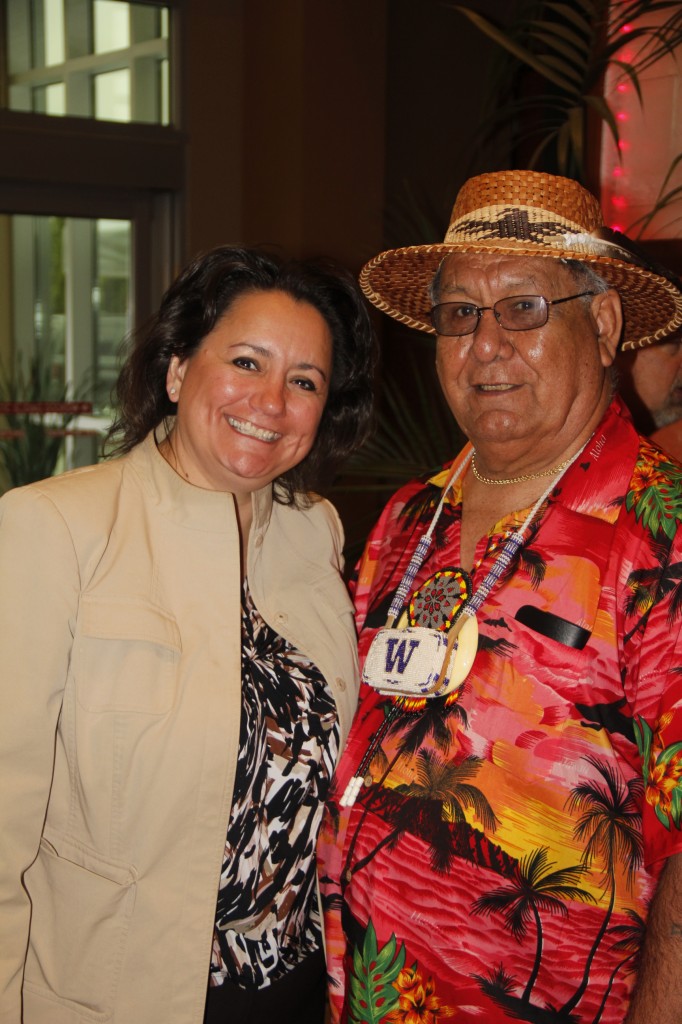
Photo: Andrew Gobin/Tulalip News
Related Links:
http://www.maryfest.org/FestivalDetails
Andrew Gobin is a staff reporter with the Tulalip News See-Yaht-Sub, a publication of the Tulalip Tribes Communications Department.
Email: agobin@tulalipnews.com
Phone: (360) 716.4188
Generations join in the spirit of slehal at the Tulalip Tribes Stick Game Tournament
By Andrew Gobin/Tulalip News, photos by Nessie Hatch-Anderson
On Saturday, May 31, 122 five-man stick game teams competed in the Tulalip Tribes Stick Game Tournament for $50 thousand at the Tulalip Amphitheater. On Sunday, June 1, 110 teams competed in the three-man tournament to close out the weekend of stick games.
“We heard a lot of people, young and old, say they really enjoyed the event, and they look forward to coming to Tulalip every year,” said Nessie Hatch-Anderson. “Family tradition is what we heard for this event. It was a clean and sober event, and it’s a tradition that goes way back to our ancestors.”
Slehal, a lushootseed word for bone games, hand games, or stick games, is a traditional form of gambling. Historically, it was also used as a way to settle disputes without violence. One of the Snohomish origin stories, depicted on one of three poles at the Tulalip Resort, tells the story of the beginning of the world, and how the humans and the animals played slehal to decide who would rule the earth, both a gamble and a dispute. Slehal honors that tradition.
Generations are brought together through stick games. Nessie’s mother, the late Barbara Hatch (Ane-Cus), lived for traditional competitions, a passion that Nessie carries on.
“Stick games and canoe races, that’s what I remember growing up,” said Nessie.
Stick gamers that have gone on were remembered at the event.
Carrie Fryberg, who chairs the stick game committee, said, “We did an honor song to honor past stick game players that are very respected throughout Indian Country and the stick game community. Big Bill and Mimi Mclean, Louie and Cookie Moses, and many members of the Tom family, who sang their family honor song.”
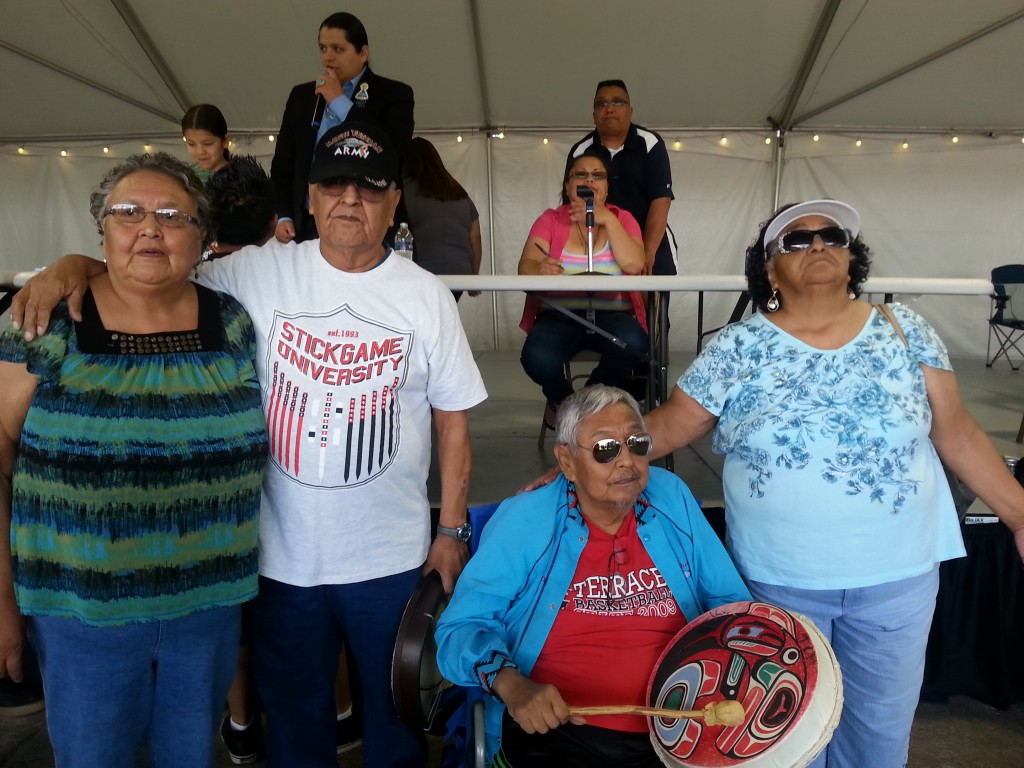
Photo: Nessie Hatch-Anderson
On Saturday, Candace Tait and her team from Lummi took first, and $25 thousand cash prize. Cassandra Kipp’s team from Lapwai came in second, winning $15 thousand, Effie Wall’s team from Fort Dushaine took third and $7,500, and Kevin Seaward’s team from Duncan took fourth and $2,500.

Photo: Nessie Hatch-Anderson
Al Tom’s team had an eight game winning streak, only to have upset in the championship bracket, taking fifth place and no winnings. They were only team from Tulalip to make it that far.
Mike Edwards and his three-man team from Muckleshoot won Sunday’s tournament.
The weekend was organized by the Tulalip’s Stick Game committee led by Carrie Fryberg.
Nessie said, “Carrie had everything organized pretty well. The weekend went very smoothly.”
Andrew Gobin is a staff reporter with the Tulalip News See-Yaht-Sub, a publication of the Tulalip Tribes Communications Department.
Email: agobin@tulalipnews.com
Phone: (360) 716.4188
On My Upcoming Trip to Indian Country
Six years ago, I made my first trip to Indian country. I visited the Crow Nation in Montana—an experience I’ll never forget. I left with a new Crow name, an adoptive Crow family, and an even stronger commitment to build a future that honors old traditions and welcomes every Native American into the American Dream.
Next week, I’ll return to Indian country, when Michelle and I visit the Standing Rock Sioux Tribe in Cannonball, North Dakota. We’re eager to visit this reservation, which holds a special place in American history as the home of Chief Sitting Bull. And while we’re there, I’ll announce the next steps my Administration will take to support jobs, education, and self-determination in Indian country.
As president, I’ve worked closely with tribal leaders, and I’ve benefited greatly from their knowledge and guidance. That’s why I created the White House Council on Native American Affairs—to make sure that kind of partnership is happening across the federal government. And every year, I host the White House Tribal Nations Conference, where leaders from every federally recognized tribe are invited to meet with members of my Administration. Today, honoring the nation-to-nation relationship with Indian country isn’t the exception; it’s the rule. And we have a lot to show for it.
Together, we’ve strengthened justice and tribal sovereignty. We reauthorized the Violence Against Women Act, giving tribes the power to prosecute people who commit domestic violence in Indian country, whether they’re Native American or not. I signed the Tribal Law and Order Act, which strengthened the power of tribal courts to hand down appropriate criminal sentences. And I signed changes to the Stafford Act to let tribes directly request disaster assistance, because when disasters strike, you shouldn’t have to wait for a middleman to get the help you need.
Together, we’ve resolved longstanding disputes. We settled a discrimination suit by Native American farmers and ranchers, and we’ve taken steps to make sure that all federal farm loan programs are fair to Native Americans from now on. And I signed into law the Claims Resolution Act, which included the historic Cobell settlement, making right years of neglect by the Department of the Interior and leading to the establishment of the Land Buy-Back Program to consolidate Indian lands and restore them to tribal trust lands.
Together, we’ve increased Native Americans’ access to quality, affordable health care. One of the reasons I fought so hard to pass the Affordable Care Act is that it permanently reauthorized the Indian Health Care Improvement Act, which provides care to many in tribal communities. And under the Affordable Care Act, Native Americans across the country now have access to comprehensive, affordable coverage, some for the first time.
Together, we’ve worked to expand opportunity. My Administration has built roads and high-speed internet to connect tribal communities to the broader economy. We’ve made major investments in job training and tribal colleges and universities. We’ve tripled oil and gas revenues on tribal lands, creating jobs and helping the United States become more energy independent. And we’re working with tribes to get more renewable energy projects up and running, so tribal lands can be a source of renewable energy and the good local jobs that come with it.
We can be proud of the progress we’ve made together. But we need to do more, especially on jobs and education. Native Americans face poverty rates far higher than the national average – nearly 60 percent in some places. And the dropout rate of Native American students is nearly twice the national rate. These numbers are a moral call to action. As long as I have the honor of serving as President, I’ll do everything I can to answer that call.
That’s what my trip next week is all about. I’m going to hear from as many people as possible—ranging from young people to tribal leaders—about the successes and challenges they face every day. And I’ll announce new initiatives to expand opportunity in Indian country by growing tribal economies and improving Indian education.
As I’ve said before, the history of the United States and tribal nations is filled with broken promises. But I believe that during my Administration, we’ve turned a corner together. We’re writing a new chapter in our history—one in which agreements are upheld, tribal sovereignty is respected, and every American Indian and Alaskan Native who works hard has the chance to get ahead. That’s the promise of the American Dream. And that’s what I’m working for every day—in every village, every city, every reservation—for every single American.
Read more at http://indiancountrytodaymedianetwork.com/2014/06/05/my-upcoming-trip-indian-country
Regulators Discuss The Future Of Coal-Fired Power In The West

By Ashley Ahearn, KUOW
SEATTLE — The Obama administration’s new rules to cut carbon emissions fueled energy sector leaders’ conversations about the future of coal in the West during their gathering here this week.
The Western Conference of Public Service Commissioners on Wednesday wrapped up its conference — a gathering of the people who decide where the region’s power comes from and how to regulate it.
Now that the Environmental Protection Agency is proposing that states cut CO2 emissions from power plants by 30 percent over the next 16 years, regulators are turning their attention to coal. Does it have a future?
“The answer is a resounding yes, the question is how much?” said Travis Kavulla with the Montana Public Service Commission. He’s one of the guys calling the shots on what kind of power his state produces, and what it will cost consumers. Montana mines and burns a lot of coal. So, as you might imagine, Kavulla’s not too pleased with the EPA right now.
“The bottom line is that the EPA seems set on establishing state by state goals, based on particular building blocks, a particularly infantilizing term, I think,” he told the crowd.
The “building blocks” include boosting energy efficiency, getting more renewable energy on the grid and using less coal.
Puget Sound Energy, an investor-owned utility based in Bellevue, Washington, gets more than 15 percent of its power from Montana coal. PSE is under mounting pressure from voters and the state government to kick its coal habit, and the new EPA rules add to that pressure.
“It’s very easy for part of our country to be rejoicing after yesterday and say ‘There, we’re just going to shut it all down.’” Well, that’s not going to work,” said Kimberly Harris, president and CEO of Puget Sound Energy. “You cannot just shut down coal units and expect for the grid to continue to operate. And we have an obligation to serve.”
Harris says that transitioning off of coal is possible, but it will take time – and states will have to work together.
“Any type of a retirement has to be transitional because we have significant decisions to make and investment and planning to do as a region. This really needs to be a regional approach,” Harris emphasized.
Washington’s in good shape to meet the EPA requirements, pretty much just by phasing out its only coal plant, which operates in Centralia. But Montana is going to need help lowering its CO2 emissions and getting more renewables online.
But who will will pay for it?
“From an investor’s point of view, all of this looks like a giant investment opportunity,” said Mike Weinstein, an investment analyst with UBS Securities in New York.
Weinstein said investors will be looking to throw money at new technology to cut CO2 emissions at the smokestack or sequester those emissions underground.
Some other winners, according to Weinstein? Renewable energy, natural gas and maybe nuclear power.
He also stressed the role of energy efficiency in helping utilities meet the EPA requirements, and keep costs down.
Getting Lean and Going Green

By Kim Kalliber, Tulalip News Writer, June 5, 2014
TULALIP, Wa. – Meet Tulalip resident Jennifer Green and her buddy Jasper. I met up with Jennifer, and her large bag of trash, this morning on the Tulalip Reservation near the Red Church. Jennifer is not only getting fit, but is helping to keep the reservation beautiful by walking twice a week, picking up litter.
Having recently shed 80 pounds, Jennifer said, “With all my new energy, I’m making it further and further around the reservation.”
According to Oprah.com, “If every person picked up just one piece of litter today, there would be over 300 million fewer pieces of litter. If every person picked up 10 pieces of litter, there would be 3 billion fewer pieces damaging our environment. If you and your friends spend just one hour today picking up litter in your own neighborhood, you will not only pick up thousands of pieces of trash, you will also make a tremendous impact on your community.”
Thanks Jennifer for making a difference in our community!
Quinault’s Taholah Lower Village to relocate due to ocean threats
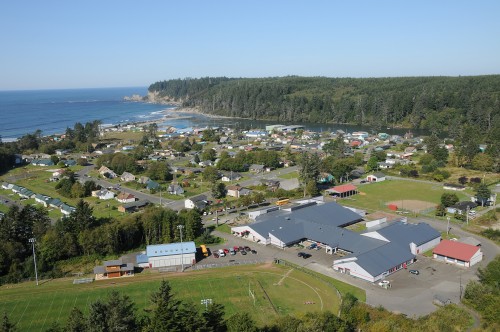
Photo courtesy of Larry Workman
By Brandi N. Montreuil, Tulalip News
TAHOLAH – On March 25, the encroaching waters of the Pacific Ocean awakened residents in Taholah, Washington, when their aging seawall was breached and flooded sections of their Lower Village. Now, the village is faced with relocation due to changes in climate resulting in rising sea levels, tsunami threats, and flood danger from the Quinault River.
The ancestral home of the Quinault people is classified as a tsunami hazard zone by the Washington Emergency Management Division and is no longer considered safe. As a result, a comprehensive master plan is being implemented that would move residents and government structures 120 feet above sea level to the Upper Village.
The risks were identified years before when the Quinault Indian Nation undertook a comprehensive analysis of the coastline after increased flooding in the Lower Village. The analysis showed deterioration of the protective berm that separates the Lower Village from the ocean water. With each large storm the ocean encroaches further into the village, making relocation necessary. “We first thought it was rain water, but in 2009 we did a walk down to the ocean line and we discovered the ocean was encroaching much worse than we thought,” said Councilman Larry Ralston, Quinault Indian Nation Treasurer.
What was uncovered was the deterioration of a protective berm that separated the Lower Village from the ocean water and with each large storm, the ocean encroached further into the village, making relocation necessary.
“We did a risk management plan and undertook an emergency preparedness evaluation and it was determined that not only are we vulnerable to the ocean encroaching, but the footprint of our Lower Village is vulnerable to liquefaction, so if we had a large earthquake, the village could actually sink
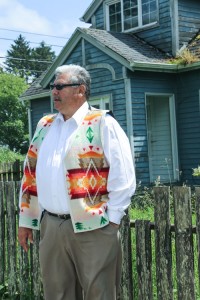
Photo/ Brandi N. Montreuil, Tulalip News
into the earth,” said Fawn Sharp, Quinault Indian Nation President.
President Sharp explained the safety of current and future Quinaults is the main priority. “We have a sacred trust and duty to those who are deeply connected to the land and their homes. It is a mix in which we have to plan carefully. We have over 1,000 residents and we have our major retail outlet, the Taholah Mercantile. We have our jail facility, courthouse, daycare and head start, and k-12 school so a number of our critical programs are located right in the heart of the village.”
“As of right now we are in the process of undertaking a feasibility study. The study will fully assess the infrastructure and the number of residents at risk, putting together a plan that we can then take to federal appropriators and members of congress, and other federal agencies in an effort to relocate the village,” said President Sharp.
Preliminary estimates for relocation cost are near $65 million and include the need to acquire land adjacent to the Upper Village, and the building of infrastructures including roadways, utilities, housing, and businesses. The loss of generational history that holds cultural relevance to the Quinault people is something that is also being considered, as is the risk of the “big one” hitting.
“As a resident of the Lower Village, we think about tsunamis more often than not. For a lot of us, we grew up listening to the ocean and we know what the weather is going to be like just by hearing the waves. You are always listening to the ocean to monitor what is going on,” said Ralston. “I am looking forward to the move, but I also know there are some houses that will be torn down like the one that my mother was born in in 1928. The worst case scenario if we don’t move everyone to higher ground, is that we get hit with a wave at two in the morning and we would only have two or three minutes to evacuate the Lower Village and we lose lives.”
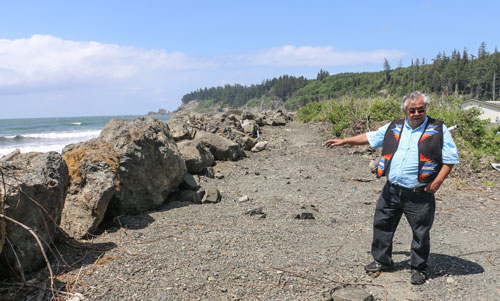
Photo/ Brandi N. Montreuil, Tulalip News
With only two ways in and out of Taholah, the risk of liquefaction puts residents at a high risk during evacuation, as roads would be inaccessible. During the event of a tsunami wave residents have limited time to move to higher ground.
Tsunami warning systems in place in Taholah include a siren monitored by the National Oceanic and Atmospheric Administrator headquarters in Seattle. In the event of an earthquake or tsunami wave the siren will go off followed by a voice telling residents to evacuate. To date, the siren has only been used during monthly test drills.
“The benefit of the relocation will be knowing that our citizens are safe, said President Sharp. “The other benefit will be the planning process will have a lot of room to expand. We have a fairly large land base adjacent to the village that we are looking at developing. There will be opportunity to create space for building a private sector economy. We are getting direct input from our membership; if you could take just a blank space, how would you want to design a community? That is the exciting part of the planning stage. There are a lot of great ideas that are emerging from our citizens, and their vision and their view of what a future Taholah will look like.”
Although relocation is necessary, residents will not be forced to move. Some residents like Quinault elder James DeLaCruz Sr. knows he will not be relocating. His house butts against the seawall, and as he explains “The Lower Village has been a part of my life as long as I can remember and this is where my home is until nature changes that.

Photo/ Brandi N. Montreuil, Tulalip News
“We believe that every citizen has that right,” said President Sharp. “We will do our best to educate our membership about the risk. We will do our best to provide our citizens the options for relocation, but ultimately we will respect that individual citizen’s absolute right to live where the Creator put them and the lands that were given to our ancestors.”
“Our ancestors had to be good stewards of the land. We have done that here at Quinault,” said President Sharp. “Yet we seem to be paying the price for others who don’t share the same values. Our ocean is becoming acidic, the ocean is encroaching into our ancient homelands, and the glaciers that feed the upper Quinault River and our prized sockeye salmon are disappearing. So while we have been good stewards, we are paying a heavy price for other peoples mistakes.”
The Taholah Relocation Master Plan includes the Quinault Planning Development and Kaul Design Associates. A three-year planning process will be implemented in phases and include gathering information, needs and choices of the community, and final plan preparation.
Brandi N. Montreuil: 360-913-5402; bmontreuil@tulalipnews.com


